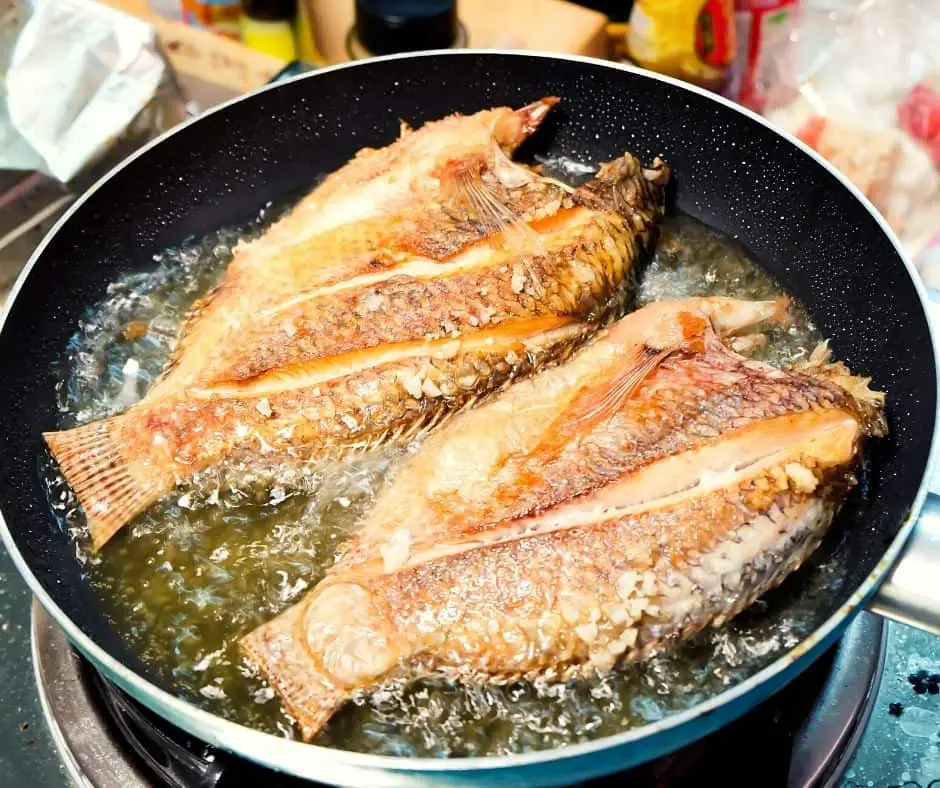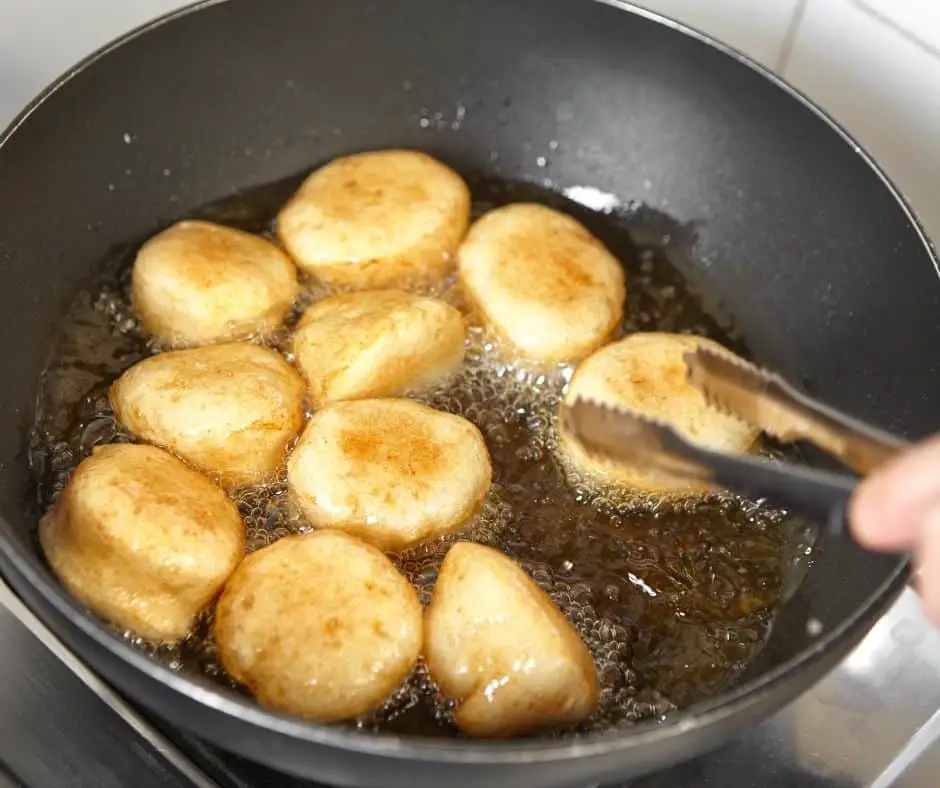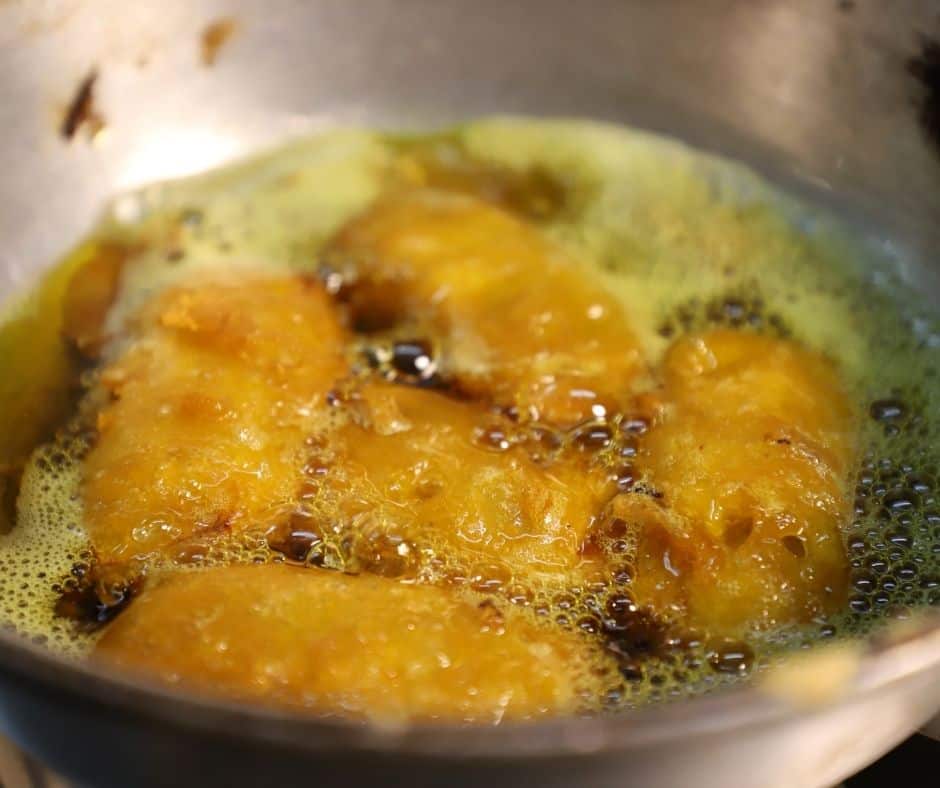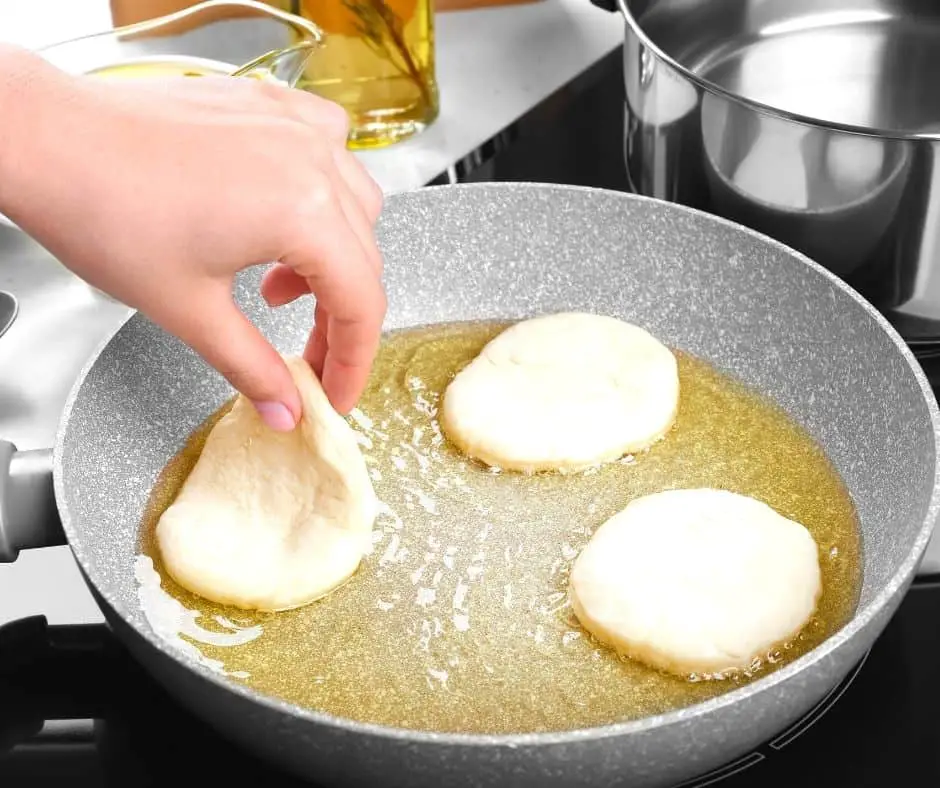Discover the advantages of shallow frying and learn how to shallow fry your food to crispy golden perfection.
Sometimes it’s hard to know when to shallow fry, pan-fry, or deep fry your food. Hopefully, this article will help you choose between these different frying methods and give you some helpful tips about the best oils and foods to use for this frying method.
What Is Shallow Frying?

Shallow frying is a cooking technique using a specific amount of hot oil on a frying pan to swiftly color the surface and seal the interior, making the food crisp and golden outside and leaving it moist and tender inside.
Here is how to do it:
- Add enough oil to cover the base of your pan, approx 1 inch (1-3 cm) deep or about one-third the height of the food being fried.
- Allow the oil to heat on medium-high heat. Then slowly add in your food. You should hear the food sizzle when it touches the oil.
- Flip the food over halfway through the cooking time.
- Using a slotted spoon or tongs, remove from the pan.
- Drain on kitchen paper towels or cooling rack to remove excess oil.
Top Tips:
- Make sure you don’t add too many items to the pan at a time. This can reduce the oil’s temperature, and you may end up with soggy food.
- Flip the food only once during cooking to achieve even cooking and maximum crispiness.
- For larger volumes of food, you may need to do multiple rounds of cooking. You can keep your fried foods warm in the oven on low heat, around 320°F (160°C).
- Pan with straight 2-inch high sides is probably the best option, but a wok pan can also work.
- Keep the oil clean from pieces of food that will start to burn and smoke.
- Make sure the food is dry to avoid splashing the oil everywhere.
Best Foods For Shallow Frying

It seems that nowadays, pretty much anything can be fried in hot oil. So if you are in the mood for something crispy and crunchy and you like to experiment, then give it a go and discover the whole world of culinary possibilities.
However, there are still certain foods that will produce the best results when combined with this cooking method.
Shallow frying is an excellent cooking method for food products that should be crisp-fried in a short cooking time. Breaded, battered, or floured foods from comfort food to snacks or even elegant appetizers taste great when shallow fried.
Here are some food ideas to try out:
- Buffalo wings
- Chicken wings
- Light falafel
- Chicken fingers
- French fries
- Chicken nuggets
- Fritters
- Frozen Gyoza
- Cuts of meat, including chops and steak
- Sausages
- Whole fish
- Fish cakes
- Battered prawns
- Vegetables
- Chicken kievs
- Fillets of pork or veal such as cutlets, medallions, and schnitzels
- Doughnuts
- Potato chips
- Cheese curds or cubes
- Fried okra
- Corn dogs
- Spring rolls
- Ravioli
- Dumplings
- Churros
- Funnel cakes
- Long johns
- Ramnut
Differences Between Shallow Frying And Pan Frying
Pan-frying and shallow frying are similar techniques, and sometimes the terms are used interchangeably.
The main difference is the volume of oil added to the pan. Pan-frying or sautéing typically uses just a few tablespoons of oil and sometimes any at all. In contrast, shallow frying can use a lot more fat, usually covering half the food’s thickness.
Differences Between Shallow Frying And Deep Frying
These are also very similar cooking techniques, with the difference that shallow frying uses less oil and is considered a less intense cooking technique than deep frying.
Shallow frying will not entirely cover the food in oil, instead only covering the lower half, which means that food still needs to be flipped halfway through cooking. Deep frying will use considerably more oil, as the food should be entirely submerged in hot oil.
Read Also: How To Deep Fry Food At Home – Oil Temperatures And Cooking Times
Which Oil Is Best For Shallow Frying?
There are various types of fats you can use, but high smoke point cooking oil will give you the best result.
There are two important criteria that oil needs to meet to be suitable for shallow frying.
- The oil can be heated up to 375°F 190°C without breaking down and start smoking, i.e., use refined oils with high smoking points. This means that extra virgin olive oil is off the cards, as this has a low smoking point and cannot reach the temperature required to make golden crispy food.
- The oil has a neutral flavor. Otherwise, the flavor of the oil can impact the taste of your food. So be careful with oils like coconut and sesame oil because of their strong, recognizable flavors.
Luckily, it is not too hard to find oils that meet both of the above criteria, and the oils are usually on the affordable side. Oils that are great for frying include peanut, sunflower, avocado, and Rice Bran Oil.
Check out the full list of best shallow frying oils below.

You can also shallow fry using clarified butter (NOT regular butter), lard, or animal fats. You may wish to use these other types of fat to achieve a different taste. Just ensure the fat can reach the appropriate temperatures for shallow frying.
Read Also: Super Easy Way To Make Clarified Butter Without Cheesecloth
Shallow Frying Temperature
Unless you want a soggy meal (which is not recommended, but no judgment if you are inclined), getting the oil to medium to high temperature is critical.
The oil temperature for shallow frying should be between 320-375°F (160-190°C). For the crispiest results but without burning your food, check the temperature with a thermometer or a small piece of food before frying.
Top Tip:
Although a thermometer certainly helps you know when your oil has reached the desired temperature, it is not essential when shallow frying. You can test the oil if sufficiently hot with two methods:
- Place the end of a wooden spoon into your oil. If bubbles form around the wood, it is hot enough to begin shallow frying.
- Add in a drop of batter and check if it sizzles.
Check Out These 6 Proven Methods: How To Tell If Oil Is Hot Enough To Fry?
Can You Reuse The Oil?

Yes, you can use the frying oil more than once; however, the quality of the oil starts to deteriorate the more you use it. Keep reusing it until the oil gets too dark, starts foaming, smoking too quickly, or develops off-flavor.
Recommended Equipment For Shallow Frying
Any large pan or wok with a wide base and steep sides will work well for shallow frying. Unlike deep frying, you do not need to use a really deep pan, but very low-sided pans should be avoided as they may pose a greater risk of injury as oil is more likely to splash.
Also, a cooling rack, tongs, or slotted spoon, and instant-read thermometer will be a great help when frying food in the oil.
Advantages And Disadvantages Of Shallow Frying

Less Oil
As mentioned, when shallow frying, you only cover the bottom half of the food with oil. Therefore, you need a significant amount less oil than if you choose to deep fry your food. Not only can this reduce waste and save you money, but it could also be a slightly healthier option.
Easier To Do With Standard Kitchen Appliances
Pretty much anyone with any standard kitchen equipment can shallow fry. You do not need any fancy equipment to achieve a great crispy result. As most people don’t have a deep fryer at home, shallow frying is usually the best option for most home cooks. Plus, the result will be very similar to deep frying, provided you remember to flip the food over during cooking.
Takes Longer To Fry
If you want your food to be evenly crispy all over, you can certainly achieve this by shallow frying. However, it may take slightly longer to cook evenly than deep frying. This is because you need to flip the food over halfway through cooking to ensure all sides crisp up.
Needs More Attention
It is more hands-on, and you need to pay attention to the food and remember to flip it halfway. You can’t just ‘set it and forget it’ and shake the frying basket and then lift the whole thing out of the fryer once the food is done.
Shallow Frying Safety Precautions
Even professional chefs can have accidents. Care should always be taken when handling hot oil, especially when heating oil near the smoking point. If you get hot oil on your skin, this could lead to serious injury. General safety advice when cooking with hot oil includes:
- Heat the oil to your desired temperature slowly. This prevents heating beyond the smoking point, which is when the oil gets most dangerous.
- Add your food into the oil slowly. Dropping the food could result in splashback and severe burns.
- When using a gas flame, make sure that the flames do not extend further than the pot’s width because hot oil can quickly catch fire.
- Never leave hot oil unattended, especially when it is on the stove. Oil fires can be dangerous if not dealt with soon after ignition.
- Familiarise yourself with basic kitchen safety and how to deal with oil fires at home.
Conclusion
Shallow frying is a very quick and easy way to make delicious, crunchy, and crispy food as this method consumes less fat which can be expensive then it is cheaper than deep frying. However, which one is the healthier option is still up for debate.
If you are really looking for a super healthy frying method check out my latest post here: Is Air Fryer Worth It? (Yes, But Here Is What You Need To Know!)
